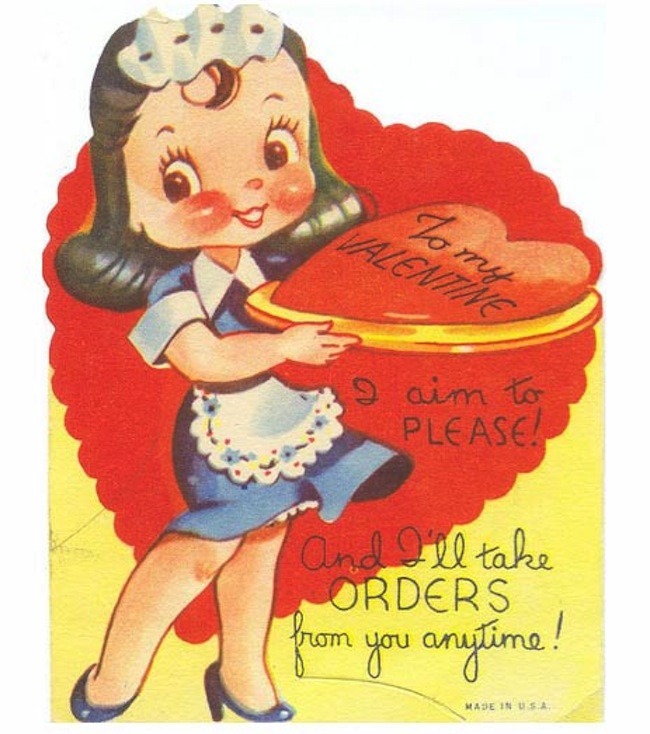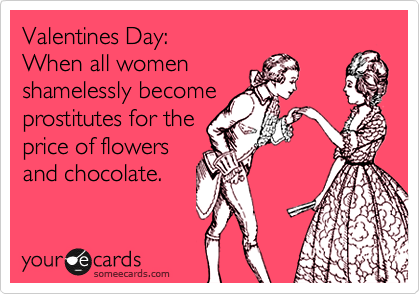The only thing that I like about Valentine’s Day is the fact that it comes along with my family’s tradition of making a chocolate torte that is basically nothing but butter, eggs, ground almonds, and sugar, which I eat for breakfast.[1]

Growing up in Canada, Valentine’s was a flurry of gender-stereotyped cards, which young children were required to distribute to their little friends in schools, following the rules of psychologically damaging fifth-grade internal politics. It was storefronts blanketed in terrible shades of pink and red; and piles of cheap chocolate that was mostly paraffin wax (my family’s torte excepted). It seemed to me, as it does to an increasing number of people, one of the most blatant attempts by struggling shops to get people spending money on things they don’t need in the wasteland between Christmas and Easter. Valentine’s Day most certainly blends sex, love, and commerce.
Recently, this hodge-podge of meaning has come under more fervent attack, as bloggers and pundits allege that Valentine’s Day is–or has become–a form of prostitution. (Crudely put: I buy you a diamond/lingerie; you have sex with me). Of course, women have reason to feel deeply insulted by this allegation, which springs as much, if not more, from good old misogyny as it does from a moral or feminist critique. Indeed, a survey of the blogs that discuss Valentine’s-as-prostitution reveal shocking levels of woman-hatred and poor writing, neither of which I wish to promote by linking them.

Yet these allegations–that romantic love and sanctioned union is only a hair’s breadth away from prostitution–can be found in earlier periods, and with very different ideas underlying them. One of the most forcefully put arguments was first-wave feminist Cicely Hamiton’s polemic, Marriage as a Trade, published in 1909. In it, she argues that women have no choice but to see marriage and love as a compulsory trade, the only occupation open to them. Marriage, she writes, is ‘a trade on the part of woman – the exchange of her person for the means of subsistence’. Hamilton explicitly compares marriage to prostitution, even arguing that the prostitute is in a stronger occupational position than the wife, if not a stronger legal one: ‘This freedom of bargaining to the best advantage, permitted as a matter of course to every other worker, is denied to [the wife].’, she wrote. ‘It is, of course, claimed and exercised by the prostitute class – a class which has pushed to its logical conclusion the principle that woman exists by virtue of a wage paid her in return for the possession of her person.’ Women are, in fact, so aware of their commercial position in relationships, Hamilton argues, that they cannot be as engaged with the notion of romantic love as men are.
Historians have supported the claims of Cecily Hamilton. They have uncovered much evidence to suggest that our current conceptions of romantic love are very modern inventions and that marriages were, for much of human history, a trade in women. These histories–and further examinations of love in the growing field of the history of the emotions–seriously challenge any concept we have of essential, eternal, unchanging love and coupledom. Historians are such a drag on V-day.
Then we have histories that challenge our binary conception of prostitution and non-mercenary sex. An excellent example here is Elizabeth Clement’s Love for Sale: Courting, Treating and Prostitution in New York City, 1900-1945 (2006), in which she blurs the line between prostitution and romantic courtship by discussing the concept of ‘treating’, a practise in which women gave sexual favours in exchange for desired goods: dresses, lingerie, jewelry, nights out. There is no denying that ‘treating’ is part of our own sexual culture, and that it reaches its heights on Valentine’s Day.
But is this entanglement of sex and commerce a BAD thing? Maybe if we spend more time thinking about the historical and present-day connections and grey areas between love and commerce, between marriage and prostitution, between commercialized sex and romantic sex, between meaningful and meaningless sex, we might start having more respect for people on all ends of this fascinating and troublesome human spectrum, and be able to more clearly see the inequalities and even the empowerments that help to shape it. Viewed at one particular angle, Valentine’s Day invites us to do just that. Maybe there’s another reason to like it besides the torte.
[1] Cut down on the sugar if you make it. You are not obligated to use Hershey’s cocoa.
 Julia Laite is a lecturer in modern British and gender history at Birkbeck, University of London. She is interested in the history of women, gender, sexuality, crime, migration, prostitution, and occasionally lorries. Her first book, Common Prostitutes and Ordinary Citizens: Commercial Sex in London, 1885-1960 was published with Palgrave Macmillan in 2011. She is currently working on trafficking and women’s migration in the early twentieth century world.
Julia Laite is a lecturer in modern British and gender history at Birkbeck, University of London. She is interested in the history of women, gender, sexuality, crime, migration, prostitution, and occasionally lorries. Her first book, Common Prostitutes and Ordinary Citizens: Commercial Sex in London, 1885-1960 was published with Palgrave Macmillan in 2011. She is currently working on trafficking and women’s migration in the early twentieth century world.

NOTCHES: (re)marks on the history of sexuality is licensed under a Creative Commons Attribution-NonCommercial-NoDerivatives 4.0 International License.
Based on a work at www.notchesblog.com.
For permission to publish any NOTCHES post in whole or in part please contact the editors at NotchesBlog@gmail.com





G’day Julia,
I read your blog because I thought it was going to be a pretty stock standard feminist critique about valentines day and marriage as prostitution blah blah blah.
I was, however, misguided!
I agree – the whole gaudy v-day enterprise is annoying at best.
It seems with your critique that marriage is akin to prostitution- certainly for the ladies (and I’m quite sure I should be saying women!). It sits really uneasily with me. It seems to me that most women I know can very easily make their own way in life and honestly, have little need for a man. There’s no arguing that women outrank men in school scores & university entrants. Women who choose a career certainly seem to earn the same as men.
I certainly don’t want to sound like a troll, and honestly I’m not. I just find it hard to think that vein married is akin to a ‘commercial prostitution’ arrangement. It seems to remove any notions of marrying just because you love, admire & respect each other. The idea that you marry someone because you truly want the best for them, that you want to stand by them in the good times or bad.
Marriage isn’t all about sex. It could be argued that, in today’s hookup culture, sex is quite easy to obtain. Sex is a big part of marriage (and the whole human existence). Could it be possible that men & women have sex just for fun, and the roses & dinner & everything else that goes along with it adds to the allure of attraction?
I’m not too sure. What I do know is I’m looking forward to reading more of your posts!
Warmest regards,
P
Thanks for your comments! Clearly, marriage and relationships mean very different things to people, and as a person I too hold many of the values you outline above. However, it wasn’t MY critique of marriage that I was highlighting, but Cecily Hamilton’s from 1909. You also have to remember that marriage and the postition of women was LEGALLY different then as well, she wasn’t necessarily arguing against women being in loving relationships with men, she was arguing against the legal and cultural conception of marriage in the early twentieth century. Ultimately, the post is about the historical ideas about love, marriage, sex, prostitution, how these ideas change over time. And how, even if we believe we’ve progressed to a different conception of love, sex, marriage, etc that there are still multiple meanings, with deep historical roots, in our modern world.
Glad you found the blog interesting!